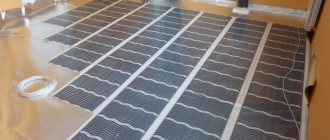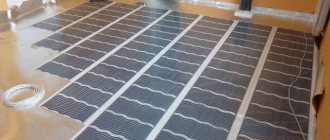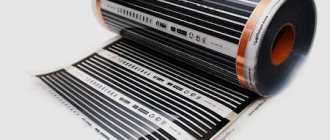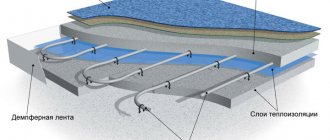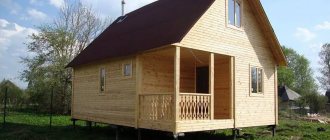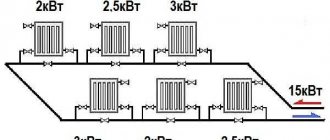The article was prepared with the participation of specialists
The low-temperature heating system “warm floor” has been very popular among owners of country houses in recent years. The advantages of this system include radiant comfortable heat, which is perceived beneficially by humans, a lower coolant temperature, which reduces heating costs, as well as increased heat storage capacity. But with all the advantages of the system, it is not without disadvantages, which can be minimized by using metal heat distribution plates to install a heated floor.
In this article, with the help of a specialist, we will answer the following questions:
- What is a heated floor system?
- What are the features of a heated floor with metal heat distribution plates?
- How to make a water-heated floor with thermoplates in a house with a wooden floor.
- How to improve heat distribution efficiency in concrete floors using metal thermoplates.
Features of Heat Distribution Plate
The plates accumulate heat and transfer it evenly to the floor covering.
The energy carrier in underfloor heating pipes does not need to be heated to high temperatures, compared to radiators, thanks to the use of heat-reflecting plates. Aluminum or steel elements have a simple structure and have no restrictions on their use.
Products from different manufacturers differ in configuration, but the general structure remains the same:
- an omega-shaped gutter runs from beginning to end and serves to install a water pipe;
- protruding stripes on the flying parts provide rigidity and compensate for thermal expansion.
Thermally conductive elements are laid in the floor structure so that the grooves coincide. During installation, no hacksaw or metal scissors are used, since the plates have convenient notches. The metal is broken off along the marks to the required length and placed in the design position.
The plate is divided into sections:
- 4 pieces of 115 mm each;
- 2 pieces of 135 mm;
- 1 part 270 mm.
If you lay the plates on a wooden base, most of the heat will remain in the room.
It is possible to install thermal plates directly into the screed, but the heat will go down to heat up the concrete. A polystyrene backing with the foil layer facing down is placed on the surface before laying the system.
Heat exchangers work effectively if mounted on an insulating material, such as extruded polystyrene foam or polystyrene foam. This limits the transfer of energy to the floor and heats up the upper floor covering. Expanded polystyrene boards are used grades FT 20/45 or FT 20/45L, the density of the foam must be at least 30 kg/m3. Grooves are cut into the insulation using a gutter knife.
What to look for when choosing?
Today, the construction market is represented by a chic selection of heat distribution sheets, all of them differ in the type of production, as well as the material from which the frame is made
To purchase a high-quality record, you need to carefully study its performance characteristics and pay attention to the following indicators of the product:. Heat capacity
Many brands present different types of thermal profiles while touting their high thermal conductivity and reflectivity. In fact, this is not true, since, regardless of the conditions of use of the heating system, the sheets will constantly heat up, so the rate of heat supply slows down
Heat capacity. Many brands present different types of thermal profiles while touting their high thermal conductivity and reflectivity. In fact, this is not true, since, regardless of the conditions of use of the heating system, the sheets will constantly heat up, so the rate of heat supply slows down.
- Efficiency. This indicator does not depend on whether the plates are made of steel or aluminum. As a rule, to improve efficiency, it is necessary to additionally use special heat-insulating materials, which, when installing the structure, are laid out in a small layer on metal fittings.
- Corrosion protection. Many people believe that if thermal sheets are constantly heated, then they are not in danger of metal corrosion, so the products do not need a special coating. This opinion is erroneous, since even the slightest penetration of moisture through the top layer of the floor at high temperatures creates favorable conditions for the formation of rust.
It is also worth noting that the choice of plates depends on the room in which the “warm” floor is planned to be installed. Each room has its own microclimate and humidity, so profiles of different models can be used, differing in protective qualities, accumulative capacity and heat capacity. For example, for bathrooms and kitchens, where there are constant temperature changes and high humidity, a product with a good anti-corrosion coating is suitable, and if the floor is laid on concrete, aluminum or copper plates will be needed to increase heat transfer.
An important indicator for the purchase will be the height of the room where the floor is laid. For tall rooms, you need to use aluminum frames; they transfer thermal energy faster, and the flow of warm air is distributed more evenly along the entire perimeter of the room.
To summarize, we can say that the plates play a huge role in the distribution system and provide good heating to the room. But in order for the design to work effectively, high-quality pipelines must also be selected for these elements. Only energy transfer depends on thermal plates. Therefore, you should also worry about the presence of an insulating substrate. Before starting installation work, it is necessary to perform correct calculations of the material and prepare installation diagrams.
To learn how to bend an aluminum plate for a heated floor, see the following video.
Purpose of plates
Metal thermoplate is used if it is not possible to make a traditional screed (buildings with wooden floors, walls made of foam blocks, etc.). Sometimes the height of the ceilings does not allow raising the base to the thickness of the heated floor. The delivery date of the object affects the choice of screed or dry installation method. Concrete gains strength within 28 days, and the system with thermoplates is ready for use after laying the finishing layer.
Heat-reflecting structures are an alternative to a water floor on a cement-sand base. The lightness of the design allows the elements to be used on any floor, since the load increases slightly.
The water pipes are tightly wrapped around the metal in the groove and heat the element. Aluminum and steel belong to the group of effective heat conductors, so they transfer energy to the floor covering. Convection in the form of streams and jets is completely absent, the surface is heated evenly. Heat is transferred more efficiently if the side parts of the thermal plate fit tightly to the base and top layer.
Procedure for replacing thermal paste on a processor
Let's move on to the most important thing and tell you in detail how to change thermal paste:
- The first step is to understand whether the thermal paste for the processor needs to be replaced at all. This is not difficult to determine. Just go into the BIOS. You can download and install the Speccy program on your PC. With its help it is also easy to find out the temperature of the central processor. It’s best to pre-load it with “heavy” applications and games. Having found out to what temperature the processor heats up, you should then go to the website of the CPU manufacturer (intel, AMD, etc.). There you can easily find the characteristics of your processor, including the maximum operating temperature. All that remains is to compare the indicators. By the way, in general for all processors 60 degrees is already bad. So keep that in mind. A good indicator is 40-45 degrees.
- The second stage is preparing the computer for replacing thermal paste. Therefore, we turn off the device. Including from the network. Then remove the back or side cover (depending on the system unit).
- Disconnect the cooler power from the main board and remove it. We also remove the radiator. Now access to the processor is open. It is advisable to remove it. Typically, this requires using a small metal lever that is mounted on the side of the processor.
- The next step is to remove the old thermal paste (from both the processor and the heatsink). This can be done using a cloth, toilet paper or cotton wool soaked in alcohol (or vodka). The main thing is not to use petroleum-based solvents. Also, after cleaning the surface of the processor, do not touch it to avoid leaving greasy stains.
- Apply thermal paste. Literally a little. Usually a volume equal to a sunflower seed is enough. Distribute thermal paste evenly over the entire surface of the processor. You need to make sure that its layer is very thin. No more than 1 mm.
- At the same time, do not spread the paste on the round chip. That's right - just squeeze a drop in the center. Then press down on top with the radiator. Due to this, the thermal paste itself will be evenly distributed over the entire surface.
- Reinstall the processor. Don't forget to clean the cooler and radiator from dust and dirt. Then we put them in place. We connect the cooler to the motherboard. Place the cover on the system unit.
That's all! Now you know how to replace thermal paste on your processor. Agree, this procedure is not at all complicated. In most cases, it helps to cope with CPU overheating.
However, what if the processor still gets hot? You can install a more powerful cooler, and also clean all the “internals” from dust. It is possible that the cause of overheating lies in the fact that there was too much thermal paste or the cooling system is not working. If the temperature continues to be high, we strongly recommend contacting a service center. Most likely, you cannot cope with the problem yourself at home.
Specifications
Dimensions of the heat distribution plate for plastic pipes with a width of 16 mm
To calculate the required amount of material, 4 - 6 plates are taken per square area. There are no rotating parts in the product range. This is due to the fact that heat transfer in these sections is negligible, and the price of the corner element will significantly increase the cost of the system. The pipes are laid out along a “snake” or “snail” contour.
Indicators of plates for heated floors:
- length element size 1 m;
- width – 130 or 110 mm;
- the groove is made for a pipe with a diameter of 16 mm;
- one product weighs 500 g.
The total weight of a heated floor with a coating is reduced by 5-7 times compared to the option on a concrete base. System power is from 50 to 200 W/m2, the figure varies depending on the type of floor finishing and pipe installation pitch (at least 125 mm). Heat-reflecting elements transmit up to 94 - 95% of heat.
Which is better: thermal paste or thermal plate, according to the editors of Zuzako
Now that we've looked at the best thermoplate models, let's look at what's better: gaskets or pastes, and what are their similarities and differences:
- The choice of thermal interface type depends on the gap between the chip and the cooling radiator. If the distance is 0.1-0.3 mm, then it is recommended to use a paste, and if more than 1 mm, a spacer is recommended.
- As a rule, the thermal conductivity of the plates is less than that of thermal paste. Therefore, the use of thermal pads with top-end powerful processors is not recommended. The exception is the thinnest metal plates, which melt at high temperatures and fill all irregularities, providing excellent cooling.
- Ease of application. This is not to say that applying paste or plate is only available to professionals and experienced users. If you follow the instructions and don't rush, even a teenager can do it. However, thermal pads are still more convenient to install: measuring, removing excess and sticking.
- The price depends on the characteristics and manufacturer of thermal paste or plates. In both categories there are budget and top-end models. The cost is not much different.
- Availability. Manufacturers offer several dozen paste-like thermal interfaces, but good gaskets can be counted on the fingers of both hands.
- Lifetime. Thermal paste dries out quite quickly and, accordingly, loses its properties at the same speed.
Each type of thermal interface has its own advantages and disadvantages, and therefore it is difficult to definitively say which one is better. Therefore, professionals recommend using plates only on laptops. This is due to the fact that the processor and video card in these devices are subject to more heat and shaking, which means that a good thermal plate will be the best option.
In addition, you should choose thermal paste for a desktop PC. On most models, the distance between the processor chip and the heatsink is minimal. It is difficult to install even the thinnest copper or aluminum thermal pad into such a gap.
Many users are interested in the question of whether thermal paste can be replaced with a plate, and vice versa. This is theoretically possible, but experts do not recommend doing this for two main reasons:
- After removing the plate and replacing it with thermal paste, the cooler radiator will not fit tightly to the video card or processor chip. This is due to the fact that, in general, gasket models are much thicker than the permissible layer of thermal paste and air will enter the gap, causing overheating of the electronic components of the PC.
- If you remove the thermal paste layer and install the plate, the pressure on the cooling system mount will increase. As a result, there may be interruptions in the operation of coolers or their complete failure.
Based on the above, you should not change one type of thermal interface to another. Otherwise, the manufacturer will not be responsible for damage or incorrect operation of the device.
Advantages and disadvantages
A heated floor without a screed is installed and heats up faster.
Installing a floor using a dry method has advantages over traditional pipe laying using a wet method. The high thermal conductivity of the metal allows the surface to be heated in a short time.
Positive aspects of using thermoplates:
- the number of plates and the weight of the structure can be easily calculated independently, since the pitch and mass of the plates are known;
- the system is simply installed with your own hands after drawing up a pipe layout plan;
- the load on parts of the floor is reduced compared to wet options;
- The size of the room in height is insignificantly reduced.
The disadvantage is that after the boiler is turned off, the metal plates cool down immediately, but the concrete retains heat for some time. The cost of thermoelements is high, but with the wet method additional materials are also purchased and the labor intensity of the work increases.
Advantages and disadvantages
The use of thermal distribution plates for heated floors provides a lot of practical advantages:
- high level of productivity. The metal profile has high thermal conductivity, and the plate module heats up quickly;
- ease of installation. Unlike the “wet” technology with concrete screed, when laying using a dry method, labor-intensive processes are not involved: the circuit of the water system is not difficult to install in heat-reflecting substrates made of profiled modules;
- speed of commissioning. After installing the structure with heat distribution plates for heated floors and a test run, the final floor covering is completed, and the system is ready for operation. In the case of installation with concrete pouring, according to the standards, it is necessary to wait up to 30 days for the screed to completely dry, only then the device can be put into operation;
- small dimensions. A warm water floor based on heat distribution plates is in demand in the design of apartments with low ceilings, as it helps reduce the height of the pie structure. Concrete screed assumes a thickness of 9-11 cm, with the use of a metal heat-reflecting substrate this figure is reduced by 3 times;
- low weight load. With the “wet” installation method, an impact on the floor weighing more than 100 kg per surface area is created. The water heated floor model with distribution plates provides a load of 10 kg per m² of flooring. This is an ideal equipment option for equipping wooden houses and buildings with weak load-bearing structures.
The disadvantages of profile plates for warm water floors include the following:
- metal modules cool down quickly after the heat generator is turned off. The concrete screed heats up slowly, but is capable of accumulating thermal potential, and when the heating circuit is turned off, it retains the heat energy for a relatively long time;
- The price of a heat distribution plate for a water heated floor varies greatly compared to the cost of a concrete screed.
Features of flat installation of a water circuit
A polystyrene backing is placed under the floor covering on top of the plates.
The system is mounted on a wooden or polystyrene base with grooves for placing the convex grooves of the thermoplates. Laminate, carpet, parquet or tiles are laid over a moisture-proofing layer. For waterproofing, polyethylene with a density of 200 microns is used.
The strips are laid out with an overlap of 10–15 cm and secured with tape to each other; the perimeter is formed with damper tape, which is adhesive to the polyethylene and the wall. If a room with increased vapor generation, for example a bathroom, an additional layer of vapor barrier is installed or a material with combined protection against moisture and steam is selected.
Isolation is performed 2 times:
- according to the floor area before laying the insulation;
- on the surface of an installed system of pipes and plates.
There are solid plates on sale without grooves for pipes, in which case the grooves are made independently. Plywood and a piece of pipe with a diameter of 16 mm are used. A groove is made in the sheet, the plate is placed on the plywood, and the groove on the metal element is pressed through the pipe. The edges of the thermal plate are leveled using improvised means.
Instead of cellular insulation, you can lay plates between wooden blocks
The procedure for assembling a heated floor:
- the coating is cleared of debris and leveled with putty or self-leveling mixture;
- the waterproofing layer is laid out;
- Thermal insulation mats are laid;
- grooves are made and heat distribution plates are installed;
- water pipes are laid;
- Thermal insulation is laid between the grooves.
The second layer of waterproofing is installed after checking the functionality of the system. The final finishing of the floor is being done.
Features of wooden water heated floors
Warm floor pie using basalt insulation and heat distribution plates
This type is installed in a wooden house or dwelling with a beamed floor made of natural material. The dry method involves a rack or modular installation system. The first type is made using boards or bars, and the second uses ready-made fiberboard blocks with ready-made grooves.
The support layer, 20 mm thick, is made of wood whose moisture content is no more than 6-10%. Hardwood boards should be 80 mm wide and up to 1200 mm long.
Composition of a wood heated floor structure:
- base with a layer of waterproofing;
- boards, modules or bars laid out according to plan;
- pipe routing using plates;
- insulation from steam and humidity;
- gypsum fiber sheet 10 mm thick;
- flooring.
The boards can be laid in a continuous layer, but you will have to make a groove in each of them for the protrusion of the thermal plate. This method is labor-intensive and expensive, since the wood is processed on a machine and there are not always conditions at home.
Another option is that the boards are laid out with a gap that matches the width and length of the convex groove of the plate. The base area for the heated floor is leveled horizontally so as not to disrupt the energy flow.
What to choose?
Let's try to answer the question, which is better for a laptop or PC? Thermal paste or thermal pad? Let's break it down point by point:
- Let's start with the fact that the thermal pad is inferior in efficiency to paste if the distance between the part and the cooling system is minimal. For example, literally 0.2-0.3 mm. If the distance is close to 1 mm, then thermal paste cannot be used. Otherwise, overheating will occur.
- Thermal pad performs well if it is used in devices where the chip and cooling radiator seats are far from each other (more than 0.5 mm). After all, if you take thermal paste here, it will be of no use. Due to the thick layer, a very low heat dissipation rate will appear. The processor or video card will start to get very hot.
- Replacing a thermal pad is often simpler than applying new thermal paste, which requires cleaning off the old paste, a thin, uniform layer, and even special tools. However, replacing the thermal pad on a processor or video card is not always easy. You need to choose the right size, take into account the thickness, the degree of compression (should not be more than 70%, otherwise due to severe deformation it will lose most of its thermal conductivity properties) and much more. etc.
- Price. This criterion will not allow us to determine which is better. Since the cost of thermal paste and thermal pads is approximately the same. The cheapest options for such thermal interfaces will cost you 100-150 rubles. However, we do not recommend saving. It is advisable to choose products whose cost exceeds 300 rubles.
- Life time. A lot depends on the quality of the thermal paste or thermal pad. Although on average the latter lasts a little longer. True, if for some reason you need to remove the cooler radiator from a video card or chip, then you will have to change both the thermal paste and the thermal pad.
- On average, thermal conductivity of thermal pads is inferior to thermal pastes, the best examples of which have indicators at the level of 8-10 W/mK. Thermal pads cannot have such values. They have a lower thermal conductivity coefficient. On the other hand, there are also thermal pastes with a thermal conductivity of 1-2 W/mK. In most cases, they will already be inferior to thermal pads.
It turns out that each option has its pros and cons. Therefore, it is impossible to say unequivocally what is better and what is worse. Experts recommend the following:
- For laptops and netbooks, use thermal pads. They argue that the processor and video chip in such devices heat up more. In addition, a laptop or netbook generally does not stand in one place. People take it with them to work, study or on a visit, which means it is often subject to shaking. In such conditions, a good and high-quality thermal pad will be more practical and reliable. Therefore, it is better to choose it instead of thermal paste.
- PC owners should give preference to thermal pastes. Indeed, on most models the gap between the processor and the cooler radiator is minimal. It is difficult to fit even a thin aluminum or copper plate here.
Criteria for selecting a heat distribution plate
The effectiveness of a heated floor depends on the underlying insulation and the finishing coating.
The choice of products consists of studying the technical characteristics and parameters. It is believed that the high thermal conductivity of the metal affects the efficiency of the system. But the degree of heating of the floor depends not only on the material of the plate. High heat capacity has a bad effect on control equipment, since the heating rate will be high.
Heat transfer is affected by:
- layout system and pipe material – plastic ones release energy longer than metal ones;
- type of lower insulation and compliance with the technology of its installation;
- type of finishing floor covering - ceramics, laminate, heats up faster than linoleum-based or carpet.
The cracks in the floor are rubbed down so that steam does not penetrate the plates - this leads to corrosion. It
is an erroneous assumption that the plates are in a heated state and do not corrode. During the operation of the house, household vapors penetrate through the finishing coatings onto the base and structure of the water floor. Condensation in a heated state is more destructive.
Pay attention to the presence of an anti-corrosion layer on the surface of the heat-reflecting plate - then you don’t have to install a layer of waterproofing when laying the system. The seller provides a quality certificate from the manufacturer to confirm the reliability of the product.
The choice is influenced by the functionality of the room. When laying on polyurethane foam in the kitchen and bath, steel plates with an anti-corrosion layer are suitable. If the base is a concrete floor slab, copper or aluminum products will work better.
Materials for production
Based on the base material, plates for warm water floors are made of steel and aluminum.
Features of steel frames for the contour
Steel heat-distributing products are treated with special anti-corrosion agents in the form of powder mixtures, since the material is not highly resistant to rust. The natural structure of the alloy does not provide for long-term operation. Profile steel substrates with gutters for laying the water circuit are not subject to mechanical stress, and the products are actively being introduced into underfloor heating systems, regardless of the type of floor covering.
Features of aluminum plates for water floor contour
Aluminum heat distribution plate models are used more often than steel counterparts. Aluminum substrates with reflective properties are of great interest to consumers. The use of modules with similar characteristics helps to increase the heat transfer effect. To enhance resistance to corrosion, the surface of aluminum products is carefully treated with special solutions.
Scope of use
The pipe system with heat distribution elements is suitable for new and reconstructed buildings. The plates are quickly installed and last a long time. Thermal distribution structures do not create problems in buildings with weakened foundations, since they add little weight to the ceiling.
Dirt and dust from the use of concrete screed materials are eliminated and labor costs for installing heated floors are reduced, so dry installation is used in working offices, retail areas, workshops and residential buildings. To install a floor in one room, you do not need to close your company or organization.
